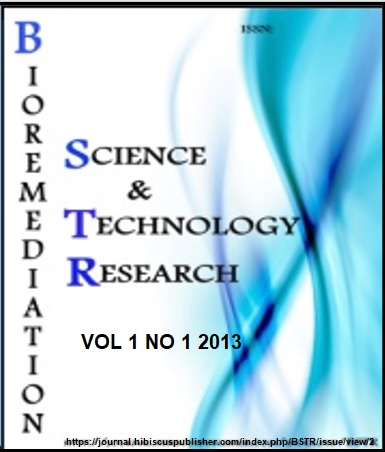Inhibitive Bacterial MTT Assay for River Monitoring of Heavy Metals
DOI:
https://doi.org/10.54987/bstr.v1i1.7Keywords:
inhibitive assay; heavy metals; S. marcescens; MTT assay, Inhibitive assay, Heavy metals, S. marcescens, MTT assayAbstract
An inhibitive assay for metals using a MTT-bacterium assay system is presented. The assay is based on the ability of respiring bacteria to reduce the tetrazolium dye MTT. Out of the 13 metals screened, silver, mercury and copper exhibit strong inhibition to bacterial respiratory activity. The calculated IC50s for silver, mercury and copper were 0.068, 0.092 and 0.517 mg/L, respectively. The IC50 values obtained for these heavy metals are comparable and in certain cases lower than existing bioassay methods such as Daphnia magna, rainbow trout, Microtox™ and papain assays. Works on real water samples from several rivers in Malaysia using the MTT–bacterium assay showed positive correlation with instrumental method (ICP-OES) in detecting heavy metals. The bacterium was tentatively identified as S. marcescens strain Dr.YS8 based on carbon utilization profiles using Biolog GN plates and partial 16s rDNA molecular phylogeny. The system could be used to biomonitor heavy metals extensively in Malaysian waters.
Downloads
Published
How to Cite
Issue
Section
License
Authors who publish with this journal agree to the following terms:
- Authors retain copyright and grant the journal right of first publication with the work simultaneously licensed under a Creative Commons Attribution License (http://creativecommons.org/licenses/by/4.0) that allows others to share the work with an acknowledgement of the work's authorship and initial publication in this journal.
- Authors are able to enter into separate, additional contractual arrangements for the non-exclusive distribution of the journal's published version of the work (e.g., post it to an institutional repository or publish it in a book), with an acknowledgement of its initial publication in this journal.
- Authors are permitted and encouraged to post their work online (e.g., in institutional repositories or on their website) prior to and during the submission process, as it can lead to productive exchanges, as well as earlier and greater citation of published work (See The Effect of Open Access).


